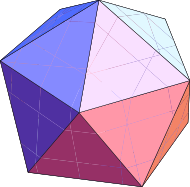From The Number Mysteries:
Some of the deadliest viruses in the biological books—from influenza to herpes, from polio to the AIDS virus—are constructed using the shape of an icosahedron.
An icosahedron is a regular solid with 20 triangular faces.

From The Number Mysteries:
Some of the deadliest viruses in the biological books—from influenza to herpes, from polio to the AIDS virus—are constructed using the shape of an icosahedron.
An icosahedron is a regular solid with 20 triangular faces.

Comments are closed.
I wonder why…
Thanks! I just got y copy of Mathematica today, and I am rediscovering it after 10 years without using it. Some things have changed a lot.
Can you make that image in python by any chance? Would love to know!
Here’s another mystery involving a Platonic solid:
http://en.wikipedia.org/wiki/Roman_dodecahedron
Reminds me of a toy my kids had, a red and blue dodecahedron with holes for various yellow shapes.
Sue, a virus can use multiple copies of a single protein to generate a shape such as an icosahedron. Therefore, it needs much less DNA or RNA to encode for protein(s) that coat the surface than if one or more large proteins were used for the surface. Viruses don’t tend to be big on genetic material. For example, HIV-1 encodes just 9 genes. An icosahedron seems to be a good arrangement to get a lot of surface coverage by repeating the same protein(s).
BTW, one way to get higher quality PNG’s from Mathematica is to rasterize at higher resolution —
http://mathematica-bits.blogspot.com/2010/12/making-anti-aliased-diagrams.html
John,
I think my kids had the same toy. While I was playing with it with my daughter, I idly wondered what conditions were sufficient to ensure that the shapes fit thorugh no more than one hole. I realized that keeping the areas of the shapes constant was enough. Mentioning it to my wife, I gave her further proof that I’m a math geek, to her great amusement.
Indeed – it’s genetic economy. A virus with icosahedral symmetry requires only one type of protein (with 60 copies) to make its protein shell (larger viruses require more types of proteins, but even then, different foldings of the same protein can be used).
Interestingly, though, it seems it’s not just the rotational symmetries that come from this icosahedral nature, but radial features too (such as how thick the protein shell can be, where features are located etc). This is still work in progress, though.
gold (number) is very dangerous (smile²)
You need to be a bit more careful and precise with the word icosahedron. An icosahedron is just a solid with 20 faces. A regular icosahedron is a Platonic solid.
See:
https://en.wikipedia.org/wiki/Icosahedron
https://en.wikipedia.org/wiki/Regular_icosahedron